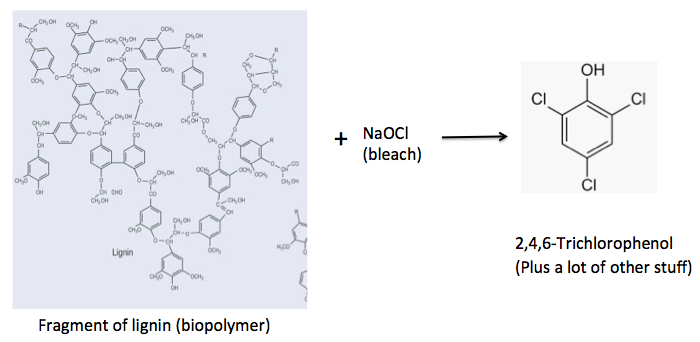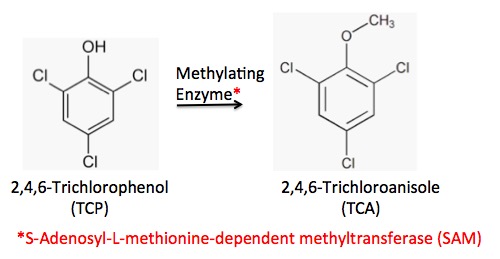Ben Valsler over at Chemistry World recently wrote an interesting piece about the chemistry and biology that leads to a strange phenomenon called "cork taint" - the microbial production of a very small amount of an otherwise-unremarkable chemical called 2,4,6-trichloroanisole (TCA). But TCA is anything but unremarkable; it does some really strange things to your sense of smell, for example, it makes wine smell like all kinds of icky things, like a wet dog or a damp basement. Wine enthusiasts may be familiar with the its common term "corked wine," which is so-named because it often results from TCA leaching from the cork into the wine.
If you'd like to understand what's going on, I must regretfully inform you that you'll first have to sit through...

Original Image: New Bedford Guide
Two chemical reactions must (sequentially) take place to form TCA, but they are very different. One is the result of an environmental pollutant making its way from groundwater into wood, primarily the cork oak (Quercus suber). The other is carried out by microbes.
Step one: Blame the environment
- During the bleaching of wood pulp, small amounts of 2,4,6-trichlorophenol (TCP) (1) are formed by the reaction of sodium hypochlorite (bleach) with lignin - a component of wood that gives it strength. (Figure 1)

Figure 1. Chlorination/oxidation of lignin gives trace quantities of TCP
Source: Science Direct
Step two: Blame the bugs.
- But TCP itself doesn't make your wine smell good, bad, or otherwise. It take nature to finish the job. Certain microbes, such as yeast and bacteria perform a methylation reaction (addition of a methyl group and loss of a hydrogen atom), which converts TCP into 2,4,6-trichloroanisole (TCA). (Figure 2)

Figure 2. TCP is converted to TCA by S-adenosyl-L-methionine-dependent methylating enzymes found in certain many microbes. S-adenosylmethionine is "nature's methylating agent." It performs this critical function in almost all living organisms.
What's so special about TCA?
This is where things get strange. To an organic chemists' eye, 2,4,6-trichloroanisole is absolutely unremarkable. It has a trichlorobenzene fragment; there are plenty of molecules containing this fragment in the universe of organic chemistry, and a methoxy (OCH3) group - also commonly found, often in natural products. TCA also looks like a big snoozer. Except it isn't. It does something really strange to your sense of smell, which is where the wet dogs and damp basements - rarely associated with wine - come in.
An article entitled "2,4,6-Trichloroanisole is a potent suppressor of olfactory signal transduction," which sounds a bit daunting, could be simplified: "2,4,6-Trichloroanisole screws up your nose."
There are a number of chemicals, which are called off-flavor substances, most arising naturally, which are responsible for altering the smell and flavor of foods and drinks, for example, musty smelling chickens, medicinal-tasting coffee, and muddy-tasting sake. These off-flavor substances are assumed to work by the chemicals binding to, and subsequently causing an unnatural excitation of certain olfactory (scent) receptors, causing them to misfire, thus the strange odors. (2)
So, it is not TCA itself that is stinking up your vino; it has no odor. Rather it's the effect of the chemical on your nose that makes you perceive one scent as another.
It's a shame that there isn't a chemical that makes a wet dog smell like wine.
NOTES:
(1)TCP has been introduced directly into the environment; it was formerly used as a pesticide. TCP in groundwater is taken up by roots and becomes a minor impurity in wood.
(2) The actual biology is very complex. Its technical term is "attenuation of olfactory transduction by suppressing cyclic nucleotide-gated channels." You don't want to know.

